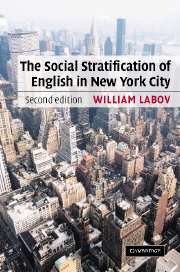Book contents
- Frontmatter
- Contents
- Introductory note
- Preface to the first edition
- Preface to the second edition: forty years later
- I Problems and methods of analysis
- II Social differentiation
- III Social evaluation
- IV Synthesis
- Glossary of linguistic symbols and terminology
- Appendix A Questionnaire for the ALS Survey
- Appendix B Anonymous observations of casual speech
- Appendix C Analysis of losses through moving of the MFY sample population
- Appendix D Analysis of the non-respondents: the television interview
- Appendix E The out-of-town speakers
- Bibliography
- Index
Preface to the second edition: forty years later
Published online by Cambridge University Press: 18 December 2009
- Frontmatter
- Contents
- Introductory note
- Preface to the first edition
- Preface to the second edition: forty years later
- I Problems and methods of analysis
- II Social differentiation
- III Social evaluation
- IV Synthesis
- Glossary of linguistic symbols and terminology
- Appendix A Questionnaire for the ALS Survey
- Appendix B Anonymous observations of casual speech
- Appendix C Analysis of losses through moving of the MFY sample population
- Appendix D Analysis of the non-respondents: the television interview
- Appendix E The out-of-town speakers
- Bibliography
- Index
Summary
The original edition of this book was printed by the Center for Applied Linguistics, photographed from the pages of the dissertation that was finished in the spring of 1966. In spite of the rough form of the diagrams, the prevalence of typos, and pages that terminated in mid-sentence, the book reached its audience and had considerable effect in stimulating further research. As the first quantitative study of a metropolitan speech community, it launched a mode of work that is well developed today in the annual NWAVE conference on New Ways of Analyzing Variation, now in its 34th year, and the journal Language Change and Variation, in its 17th year.
SSENYC introduced a number of concepts that have proved useful in the study of change and variation: the linguistic variable; social and stylistic stratification; the cross-over pattern; apparent time; covert prestige. It also introduced a number of procedures that were new to linguistic studies: subjective reaction tests to measure the effect of particular linguistic variables; self-report and linguistic insecurity tests. Many of these methods and results were encapsulated in chapters of Sociolinguistic Patterns (1972a) and developed further in later publications, especially those connected with the study of Linguistic Change and Variation in Philadelphia which followed (see Chapter 15).
There were also aspects of this work that were not so widely generalized, and when the book went out of print, were not so often reproduced in the work of others.
- Type
- Chapter
- Information
- The Social Stratification of English in New York City , pp. xi - xiiPublisher: Cambridge University PressPrint publication year: 2006



